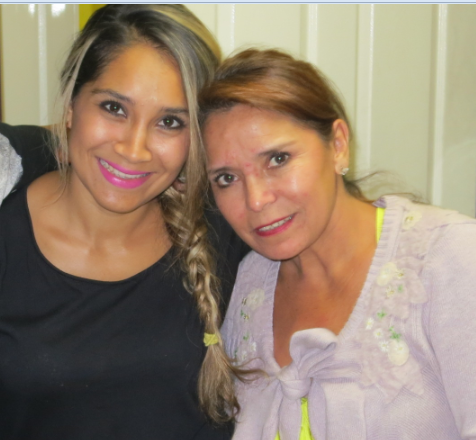“People have a lot of misconceptions of vitiligo such as it being contagious, hereditary, and painful, but all of that is not true”
By NAOMI OGALDEZ
EL NUEVO SOL
Queens, New York-Isabel Goncalves was diagnosed when she was four years old. “I was overwhelmed, shocked, and cried when I heard the news of her diagnosis of vitiligo,” said Goncalves’ mother, Maria Gonzalez.
Now that Goncalves is 12-years-old, eight years later, her skin depigmentation has spread throughout her whole body, except her face.
“She is really confident. She doesn’t like to cover up her vitiligo, ” said Gonzalez.
Even though, she is confident in her own skin, Goncalves said, people still look at her differently and, at times, make her the outcast. “On a daily basis, people are constantly making fun of me and they say I look like a cow. They are constantly saying I look weird. I am bullied,” she said.
Gocalves has vitiligo.
WHAT IS VITILIGO
The Indian Journal of Dermatology stated that about one to two percent of the world’s population suffers from this disease. This skin depigmentation affects all ethnic groups and racial groups equally. Although it may seem that Latinos and African Americans are more affected because of their darker skin color, but in reality, they are not.
According to Vitiligo Support International, half of people with vitiligo have had it developed before the age 20 and about 95 percent get it before the age of 40.
“I thought I was the only one that had it, but, in reality, there are a lot of people that have it,” said Alejandra Riera, from San Juan, Puerto Rico, who has had vitiligo for 15 years. “People have a lot of misconceptions of vitiligo such as it being contagious, hereditary, and painful, but all of that is not true.”
The cause of vitiligo is still unknown, however, there are various scientific theories to the cause of vitiligo.
Clinuvel Pharmaceuticals, a global biopharmaceutical company focused on developing drugs for the treatment of skin disorders, stated that vitiligo is characterized by the destruction of melanocytes pigment cells that stop functioning, which causes the skin that is affected to become white in color.
“In order for this to happen something has to precipitate this dysfunction in the immune system, something coming [from] within, such as a sunburnt, pregnancy, physiological and psychological stress, bug bites, certain chemicals, and the environment,” said Dr. Raymond Boissy, President of the National Vitiligo Foundation and Director of Basic Science Research at the University of Cincinnati College of Medicine, who has studied vitiligo for more than 30 years.
Several genes have to dysfunction in order for someone to be susceptible to this complex, multi-genetic disease.
“I would describe vitiligo as the cancer or the AIDS of the 2000 because people are afraid to come out,” said Dr. Boissy. “Like cancer and HIV, therapies have developed, people with those diseases have come out and advocate for themselves, which has helped bring awareness and a better life for them. I see the same happening for vitiligo. I see the renaissance in the horizon.”
Although, there is hope in the development of a cure and awareness about vitiligo, there are still issues concerning this disease. First off, there are some health insurance companies that don’t cover vitiligo patients.
Health insurance plans sometimes consider treatments for vitiligo to be cosmetic. Most health insurance plans will not cover medical care for cosmetic purposes. For that reason, “most treatments are not to cure vitiligo, they are to conceal or lessen the appearance of white patches. This strongly suggests that the treatments are for cosmetic reasons rather than medical reasons,” said Lisa Dahl, health insurance agent at Hoffman Brown Company. This has also given a reason to Mayo Clinic to state in their website that “medical treatment for vitiligo isn’t always necessary.” According to Boissy, about 60 percent of insurance companies cover vilitigo patients, the other 40 percent does not.
“It’s not a cosmetic issue, it’s a disease, we know that there are genes that cause it,” he said.
For that reason, he went on to say that without pigmentation in the skin, people are more susceptible to skin cancer and skin aging. In addition to affecting the skin, it can also have a dramatic auto immune response, which can affect other parameters such as the thyroid, amino glands, and the joints can develop arthritis or diabetes.
LIVING WITH THE DISEASE
Danny Arcanjo, 20-year-old, from Newark, New Jersey, who is the first in his family to have vitiligo, has had it for four years now. His insurance company doesn’t cover the cost for his treatments, so he has to pay out of his pocket for them. He has paid $2,500 to get started on his skin graphing and laser treatment. Arcanjo is required to visit the dermatologist on a weekly basis– each session costs $200.
Beyond the external physical changes and battles for insurance coverage that vitiligo patients undergo, many vitiligo patients have also been affected psychologically.
“I have seen a lot of people that have vitiligo get really depressed, angry, sad, paranoid, pessimistic, and negative because you are stuck with it for life. They still haven’t found a cure for it,” said Arcanjo.
Arcanjo went on to say that people should be aware about vitiligo because it could help prevent and solve many problems for the vitiligo community such as the psychological affects that may occur from having this skin depigmentation. When people discriminate people with vitiligo, they don’t realize that they are harming them psychologically to the point of giving them a reason to commit suicide.
Also, with awareness, many people in this community would be able to achieve their dreams, instead, of having to change them.
Before he had vitligo, he was on his way to becoming a professional soccer player. His vitiligo doesn’t let him be out in the sun too much, so he had to give up that dream. He said he is only one of many who have had to alter their hopes and dreams.
The psychological ramifications of vitiligo can be seen in various patients that have it.
“It’s not only a depigmentation, a cosmetical problem, it’s physical, psychological, and it deals with your health. You will never know how it feels until you have it,” said 35-year-old mother, Johana Galindez from Long Island, New York, who is the first in her family to get vitiligo.
She experiences psychological affects from having vitiligo daily. “I hate when people stare at me, I try to hide my hands. On a daily basis, I experience a lot of negativity, it feels like a roller coaster. I know beauty comes from within, but it is very hard thing to accept, especially, if you are a person like me who was very active and had a big open social life,” said Galindez
At the age of 26, she was diagnosed with vitiligo. This caused her to end her dancing career in New York. “People don’t tell you up front, the producers, the teachers, and the cast members, but you know inside that people don’t see you the same way. They don’t care the same way,” said Galindez
###
A way you can help out this community and bring awareness is by supporting the National Vitiligo Foundation. The organization is looking for volunteers and donations. This organization helps advocate and bring awareness about vitiligo, counsels’ patience that have vitligo and their family members, and funds scientific research in trying to find a cure and treatments for vitiligo. Since it’s a non-profit organization, they depend on the charity and donations for their funding. For more information, please contact info@nvfi.org or call 513-541-3903 from 9 AM – 3 PM EST. Donations may be mailed to NVFI P.O. Box 23226 , Cincinnati, Ohio 45223 or you can donate online at www.nvfi.org/member/donate.php
Tags: cosmetic issues Dr. Raymond Boissy Latinos Naomi Ogaldez National Vitiligo Foundation psychological affects skin depigmentation skin disease vitiligo vitiligo awareness Vitiligo Support International




















